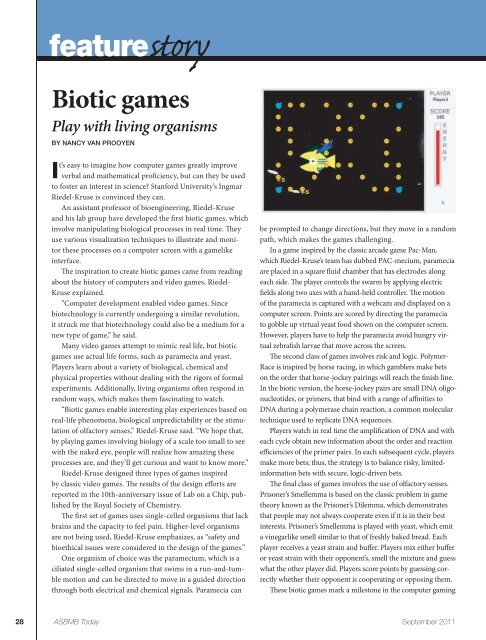asbmbnews
asbmbnews
asbmbnews
You also want an ePaper? Increase the reach of your titles
YUMPU automatically turns print PDFs into web optimized ePapers that Google loves.
featurestory<br />
Biotic games<br />
Play with living organisms<br />
BY NANCY VAN PROOYEN<br />
It’s easy to imagine how computer games greatly improve<br />
verbal and mathematical proficiency, but can they be used<br />
to foster an interest in science? Stanford University’s Ingmar<br />
Riedel-Kruse is convinced they can.<br />
An assistant professor of bioengineering, Riedel-Kruse<br />
and his lab group have developed the first biotic games, which<br />
involve manipulating biological processes in real time. They<br />
use various visualization techniques to illustrate and monitor<br />
these processes on a computer screen with a gamelike<br />
interface.<br />
The inspiration to create biotic games came from reading<br />
about the history of computers and video games, Riedel-<br />
Kruse explained.<br />
“Computer development enabled video games. Since<br />
biotechnology is currently undergoing a similar revolution,<br />
it struck me that biotechnology could also be a medium for a<br />
new type of game,” he said.<br />
Many video games attempt to mimic real life, but biotic<br />
games use actual life forms, such as paramecia and yeast.<br />
Players learn about a variety of biological, chemical and<br />
physical properties without dealing with the rigors of formal<br />
experiments. Additionally, living organisms often respond in<br />
random ways, which makes them fascinating to watch.<br />
“Biotic games enable interesting play experiences based on<br />
real-life phenomena, biological unpredictability or the stimulation<br />
of olfactory senses,” Riedel-Kruse said. “We hope that,<br />
by playing games involving biology of a scale too small to see<br />
with the naked eye, people will realize how amazing these<br />
processes are, and they’ll get curious and want to know more.”<br />
Riedel-Kruse designed three types of games inspired<br />
by classic video games. The results of the design efforts are<br />
reported in the 10th-anniversary issue of Lab on a Chip, published<br />
by the Royal Society of Chemistry.<br />
The first set of games uses single-celled organisms that lack<br />
brains and the capacity to feel pain. Higher-level organisms<br />
are not being used, Riedel-Kruse emphasizes, as “safety and<br />
bioethical issues were considered in the design of the games.”<br />
One organism of choice was the paramecium, which is a<br />
ciliated single-celled organism that swims in a run-and-tumble<br />
motion and can be directed to move in a guided direction<br />
through both electrical and chemical signals. Paramecia can<br />
be prompted to change directions, but they move in a random<br />
path, which makes the games challenging.<br />
In a game inspired by the classic arcade game Pac-Man,<br />
which Riedel-Kruse’s team has dubbed PAC-mecium, paramecia<br />
are placed in a square fluid chamber that has electrodes along<br />
each side. The player controls the swarm by applying electric<br />
fields along two axes with a hand-held controller. The motion<br />
of the paramecia is captured with a webcam and displayed on a<br />
computer screen. Points are scored by directing the paramecia<br />
to gobble up virtual yeast food shown on the computer screen.<br />
However, players have to help the paramecia avoid hungry virtual<br />
zebrafish larvae that move across the screen.<br />
The second class of games involves risk and logic. Polymer-<br />
Race is inspired by horse racing, in which gamblers make bets<br />
on the order that horse-jockey pairings will reach the finish line.<br />
In the biotic version, the horse-jockey pairs are small DNA oligonucleotides,<br />
or primers, that bind with a range of affinities to<br />
DNA during a polymerase chain reaction, a common molecular<br />
technique used to replicate DNA sequences.<br />
Players watch in real time the amplification of DNA and with<br />
each cycle obtain new information about the order and reaction<br />
efficiencies of the primer pairs. In each subsequent cycle, players<br />
make more bets; thus, the strategy is to balance risky, limitedinformation<br />
bets with secure, logic-driven bets.<br />
The final class of games involves the use of olfactory senses.<br />
Prisoner’s Smellemma is based on the classic problem in game<br />
theory known as the Prisoner’s Dilemma, which demonstrates<br />
that people may not always cooperate even if it is in their best<br />
interests. Prisoner’s Smellemma is played with yeast, which emit<br />
a vinegarlike smell similar to that of freshly baked bread. Each<br />
player receives a yeast strain and buffer. Players mix either buffer<br />
or yeast strain with their opponent’s, smell the mixture and guess<br />
what the other player did. Players score points by guessing correctly<br />
whether their opponent is cooperating or opposing them.<br />
These biotic games mark a milestone in the computer gaming<br />
28 ASBMB Today September 2011






